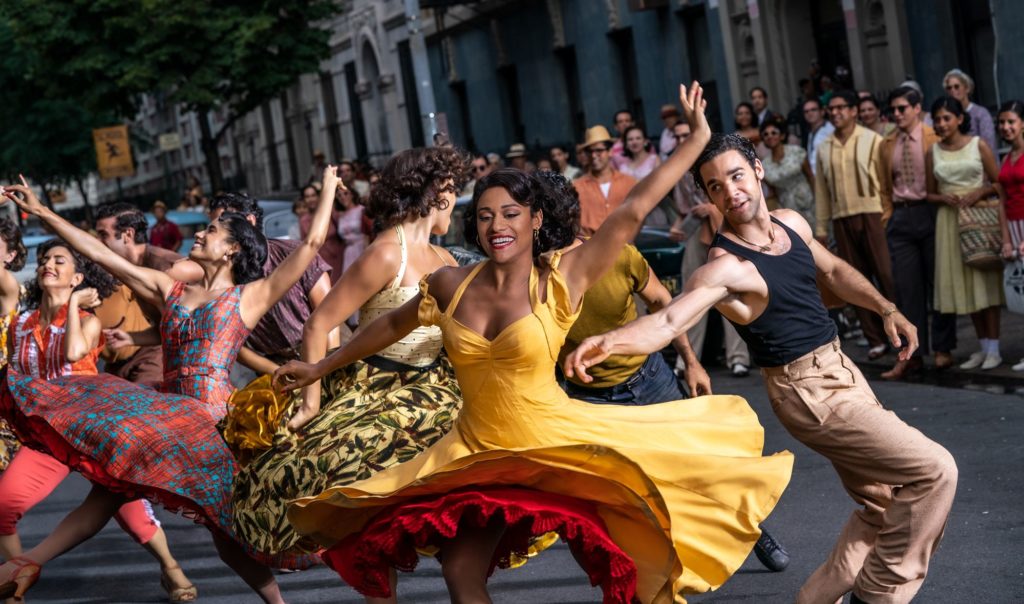THE HANGOVER REPORT – Steven Spielberg’s WEST SIDE STORY unearths the musical’s raw, beating heart without altering its essence
- By drediman
- December 17, 2021
- No Comments

Why mess with a classic movie musical, especially one as widely revered as West Side Story? As a cinematic experience, the original film (co-directed by Jerome Robbins and Robert Wise), as adapted from the 1957 stage musical, still remains compelling viewing, particularly as a meticulous time capsule of the golden age of Broadway and the musical itself. For those of you who haven’t been exposed to the piece, West Side Story is a serious-minded integration of song, dance, and story that updates Shakespeare’s Romeo & Juliet to the gang-ridden, post-World War II tenements of New York’s Upper West Side. Arguably, what’s dissipated from the 1961 Oscar-winning film over the years is a sense of danger and urgency that must have socked viewers in the gut when it was initially released. Leave it to Steven Spielberg and his team of adapters sixty years on to unearth and reveal once again – without having to alter the work’s essence – the musical’s raw, beating heart.
The most significant changes come by way of playwright Tony Kushner’s screenplay, which smartly updates Arthur Laurents’s now creaky work (thankfully, Leonard Bernstein and Stephen Sondheim’s glorious and immortal score remains completely intact). Mr. Kushner’s revisal brings historically based neighborhood gentrification and the blatant racism of the time into sharp focus, injecting a sense of real desperation and harrowing authenticity into the gangs’ street squabbles over increasingly diminishing street territory. Another significant and inspired change is the character of Doc – now Valentina – who is played by Rita Moreno (the original film’s Anita) and now becomes a central character in the proceedings, as well as the bruised but hopeful moral nexus of the film. Other changes don’t change the film’s texture too drastically, including the recasting of the order and settings of certain scenes and songs (e.g., the earlier placement of “Cool”, the re-setting of the problematic “I Feel Pretty”), which aid in strengthening the through-line of the narrative, as well as the dynamism and forward momentum of Janusz Kaminski’s thrilling cinematography. Unsurprisingly, the new choreography by New York City Ballet’s Justin Peck (one of the most sought after dance-makers to emerge in the last decade) doesn’t reinvent Robbins’ iconic stylized physical vernacular, so much as introduce punchier, less flighty movements that further emphasize the coiled energy and frustration of the characters.
With such a vivid backdrop, the film demands to be an enveloping, immersive experience, which works in favor of some performances more than others. As Bernardo and Anita, David Alvarez and Ariana DeBose don’t veer too far from the characters’ original mold but nonetheless smolder and captivate whenever they’re in the frame, memorably bringing brash dignity and uncontainable sensuality to their performances. Brilliantly reconsidered, however, is the character of Riff, whom the lanky Mike Faist tragically portrays with a knowing desperation akin to an abused animal trapped in a dead end alley. As Maria and Tony, Rachel Zegler and Ansel Elgort are young and gorgeous specimens with fine voices, but their doomed love story doesn’t quite feel quite as reinvigorated as the drama of the world that’s literally crumbling around them. And then there’s Ms. Moreno, whose performance gorgeously connects past and present as if to remind us that the social concerns of the musical then are still very much with us today.
HIGHLY RECOMMENDED
WEST SIDE STORY
Film, Musical
In theaters
2 hours, 35 minutes

 Copyright © 2025
Copyright © 2025
Leave a Reply